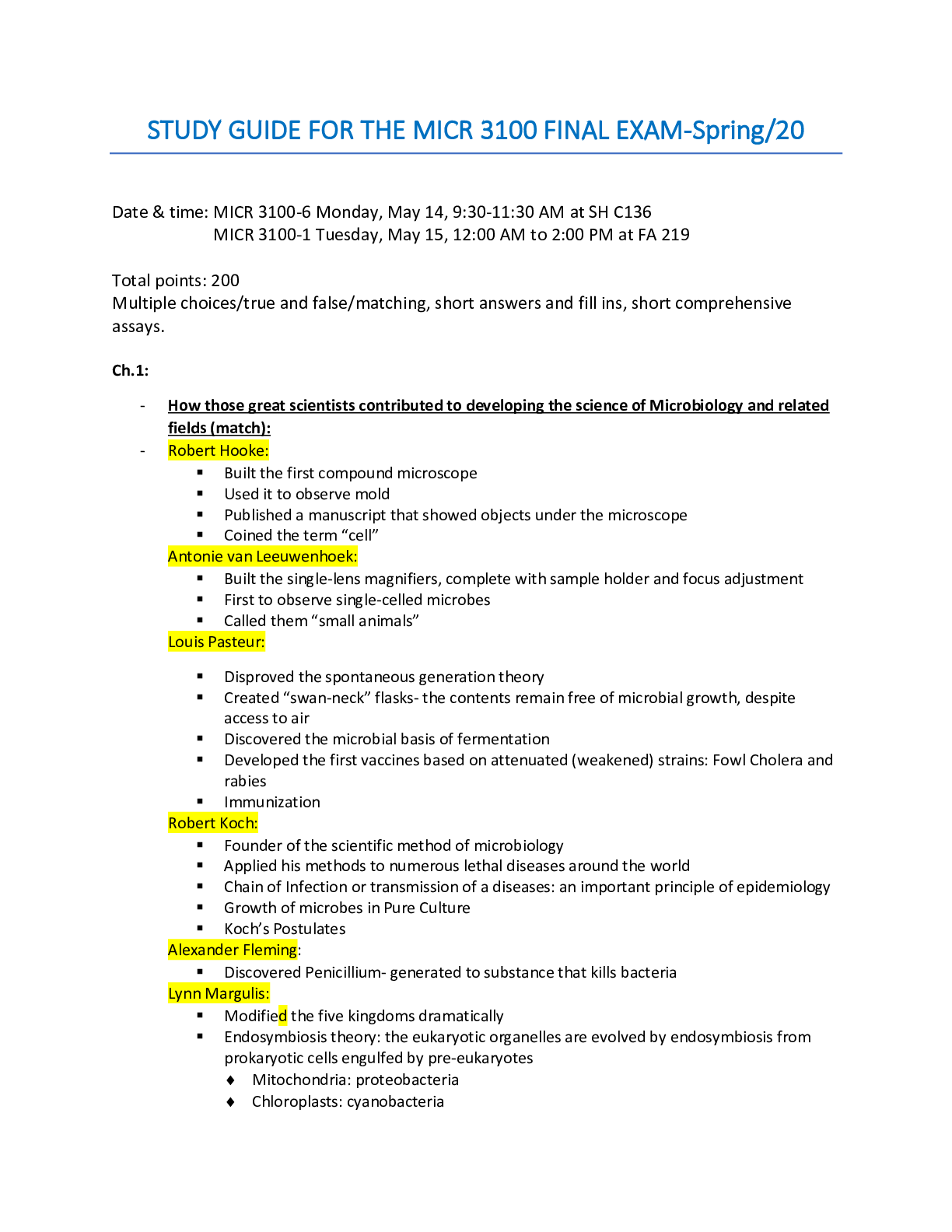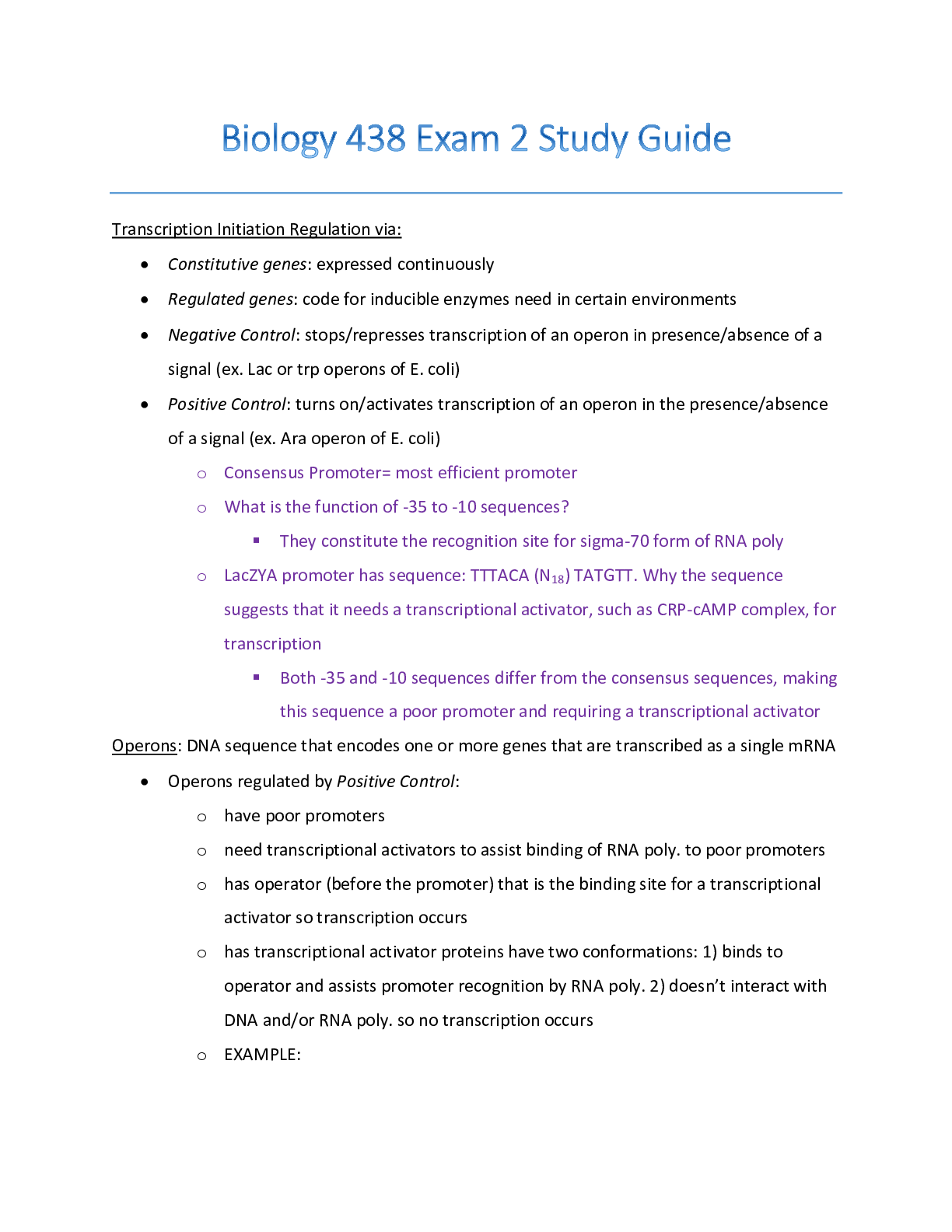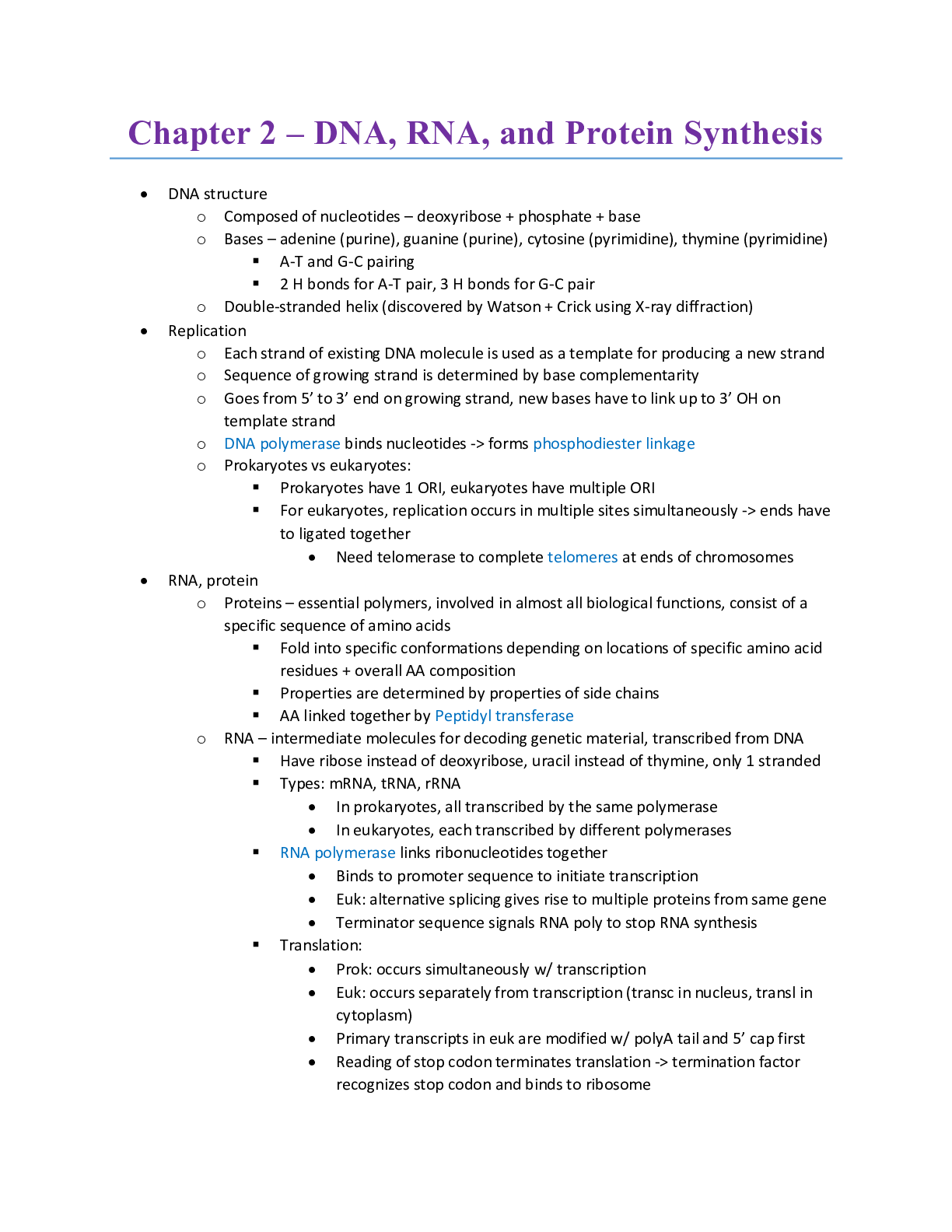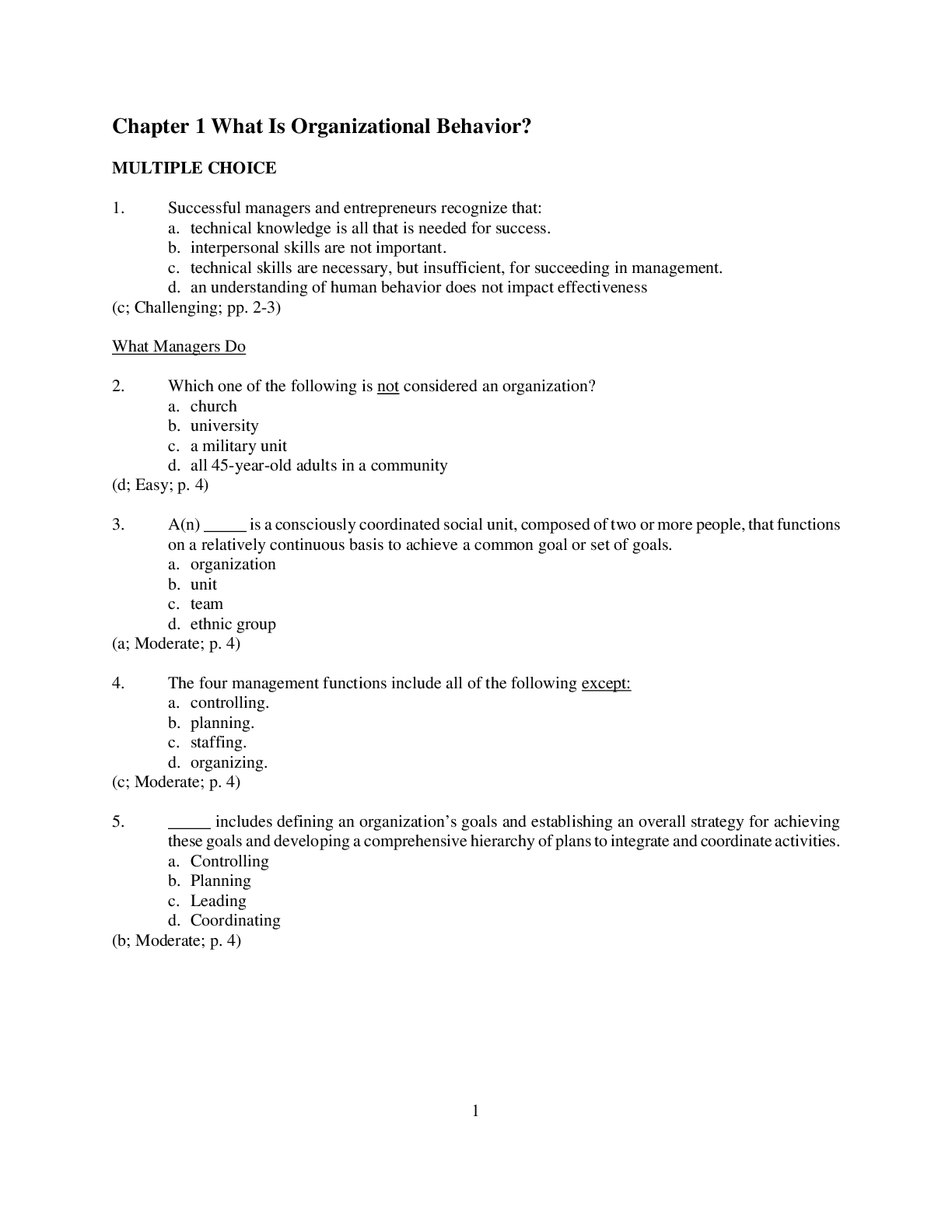Biology > STUDY GUIDE > Study Guide > University of Louisville BIO 240- Rabin Exam 2 Study Guide (All)
Study Guide > University of Louisville BIO 240- Rabin Exam 2 Study Guide
Document Content and Description Below
University of Louisville BIO 240- Rabin Exam 2 Study Guide Phospholipids Make up the phospholipid bilayer Amphipathic molecule= partially hydrophilic and hydrophobic 2 parts= hydrophi... lic head and hydrophobic tail Hydrophobic tail= fatty acids linked by C-H bonds, non-polar (because of C-H bonds) making it hydrophobic Hydrophilic head= made of choline, PHOSPHATE GROUP, and glycerol; charged and/or polar making it hydrophilic Move around (twirl), but cannot flip sides because hydrophilic head cannot cross hydrophobic tail region Can be saturated/unsaturated which affects fluidity (see cholesterol) Fluid Mosaic Model Components of membranes Extracellular= Hydrophilic – Intermembrane= hydrophobic – Intermembrane – hydrophilic Phospholipid bilayer Cholesterol (in phospholipid bilayer) Integral proteins (stretch across membrane) Peripheral proteins (intermembrane side) Cytoskeleton (intermembrane side) Glycoproteins (extracellular side, used for cell-cell communication) Glycolipids (extracellular side, attached to glycoprotein ^^, used for cell-cell communication) Saturated vs. unsaturated membrane Saturated= viscous= fatty acids in tails have NO double bonds, no kinks in phospholipid tails, straight tails= ability to pack closely together= minimal fluidity= less movement in membrane Unsaturated= fluid= fatty acids have 1+ double bonds= kinks in phospholipid tails, bent tails= unable to pack closely together= more fluidity= more movement in membrane Most membranes have medium fluidity Cholesterol In membrane between phospholipids, regulates phospholipid movement Warm temperatures= restrains movement= more tight packing Cool temperatures= promotes movement= less tight packing Temperature changes= different cholesterol effects because it prevents phospholipids from moving out of the membrane when hot, and from not moving and freezing when cold Integral membrane proteins Stretch across membrane Amphipathic Transport proteins= carrier and channel Used in facilitated diffusion and active transport Carrier proteins= change in shape, transport smaller polar organic molecules, ACTIVE diffusion ONLY, hydrophilic route Channel proteins= do NOT change shape, continuous path across membrane, PASSIVE transport, hydrophilic route for smaller polar molecules and ions, Peripheral membrane proteins Does not extend to both sides of the membrane Intermembrane side ONLY Responsible for cell signaling (molecules can bind to this protein on the outside to change cytoplasm) 6 Jobs of membrane proteins A- Transport B- Enzymatic activity C- Attach to cytoskeleton and extracellular membrane D- Cell to cell recognition (glycolipids and glycoproteins) E- Intercellular joining (ex. gap and tight junctions) F- Signal transduction Sidedness of membranes See fluid mosaic model and components of membranes Types of molecules that can cross the membrane Small non-polar molecules (hydrocarbons, O2 and CO2)= hydrophobic, can cross easily WITHOUT TRANSPORT PROTEIN Polar molecules (H20, sugars)= hydrophilic= can’t pass easily through hydrophobic part, NEEDS TRANSPORT PROTEIN Ions (polar) (Na+, K+, Ca 2+, Cl-)= hydrophilic= can’t pass easily through hydrophobic part, NEEDS TRANSPORT PROTEIN Membrane transport- Active Moves substances AGAINST concentration gradient Low high Requires energy ALWAYS use carrier transport proteins Sodium potassium pump= COtransport= Na+ low, K+ high inside cell= Na+ high, K+ low outside of cell= moves Na+ to outside of cell= moves K+ to inside of cell Steps of SPP= 1. Na+ binds to pump in cytoplasm, affinity of Na+ is high; 2. Na+ binding stimulates phosphorylation of ATP (electron transport chain creates gradients); 3. Phosphorylation (creates gradients), change in protein shape, low affinity for Na+, releases Na+ out of the cell; 4. New shape has high affinity of K+, binds to extracellular side, triggers release of phosphate group; 5. Loss of phosphate group, original shape (cycle), low affinity of K+; 6. K+ released to intermembrane space, affinity Na+ is high, cycle repeats Membrane transport- Passive Moves substances WITH concentration gradient High low NO ENERGY REQUIRED Diffusion, facilitated diffusion and osmosis Diffusion= non-polar hydrophobic particles= WITHOUT TRANSPORT PROTEINS= diffuse until equilibrium (not in living cells though) Facilitated diffusion= polar hydrophilic molecules= NEEDS TRANSPORT PROTEINS!!= water= aquaporin transport proteins, ions= channel transport proteins Osmosis= diffusion of water Membrane transport- Bulk (Endocytosis vs Exocytosis) Big molecules Requires energy Particles packaged in vesicles NO PROTEINS Endocytosis= inward folding of membrane, vesicle forms around molecule, decreases membrane surface area, vesicle binds with intercellular side of membrane, contents spill INTO cell Exocytosis= vesicle forms in cytoplasm, binds with extracellular side of membrane, contents spill OUTSIDE of cell [Show More]
Last updated: 2 years ago
Preview 1 out of 21 pages

Buy this document to get the full access instantly
Instant Download Access after purchase
Buy NowInstant download
We Accept:

Reviews( 0 )
$7.00
Can't find what you want? Try our AI powered Search
Document information
Connected school, study & course
About the document
Uploaded On
Aug 02, 2022
Number of pages
21
Written in
Additional information
This document has been written for:
Uploaded
Aug 02, 2022
Downloads
0
Views
167



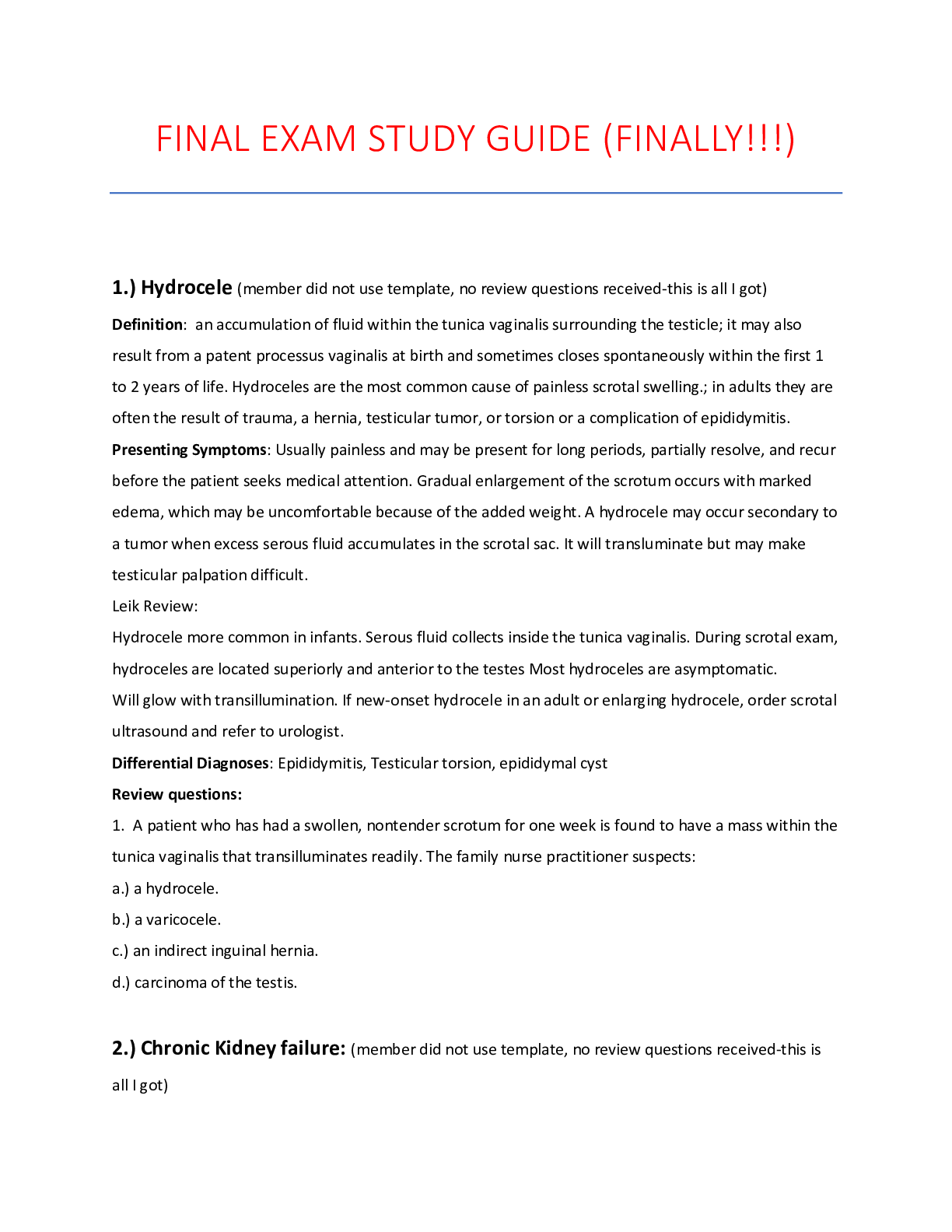
-3-168.png)




